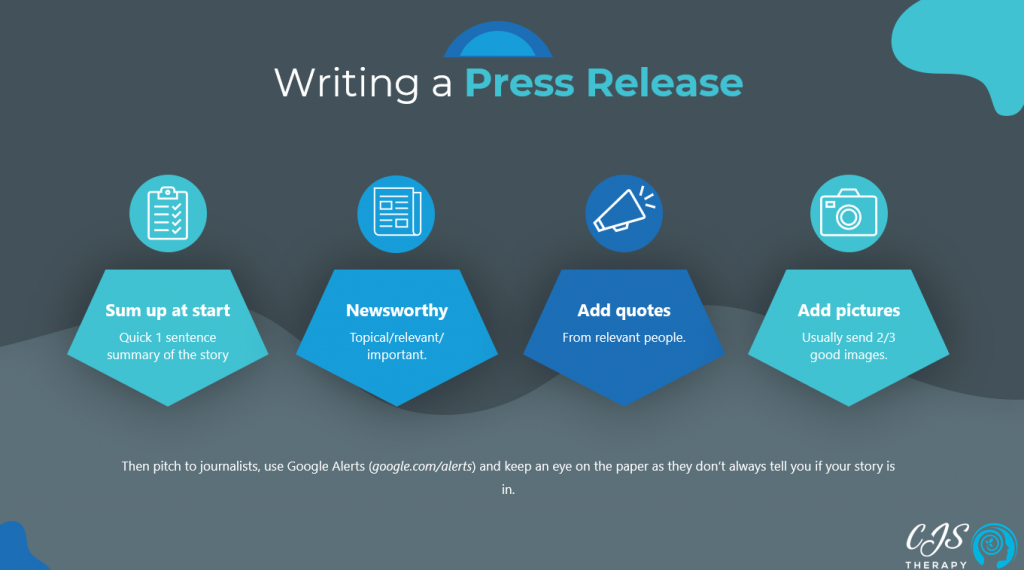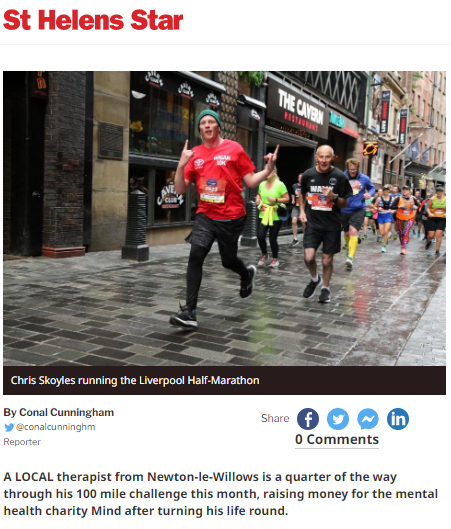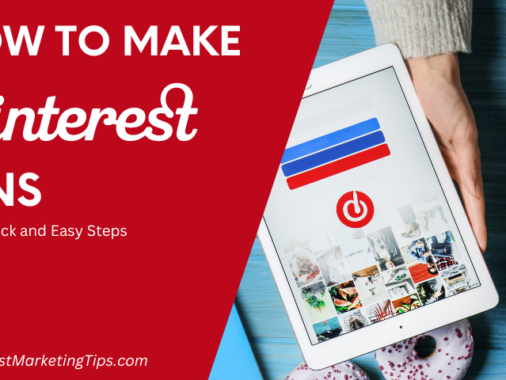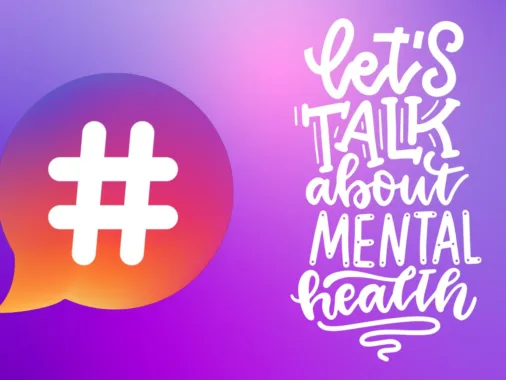Did you know that spending over the odds on advertising isn’t the only way to get your therapy practice in the newspapers?
If you can come up with a newsworthy story relating to you and/or your practice, and if you know how to write a simple-yet-compelling press release, you may be able to get yourself featured in your favourite paper without paying a penny.
Below, I’ll talk you through a straightforward eight-step process that you can use to get your story out to the papers and generate some free publicity.
What is a Press Release, and Why Write One?
A press release is a short news story that a business sends to targeted members of the media to generate press coverage of an event, a new product or service, or a campaign.
Press releases are typically written in the same style and tone as a published news story and generally follow a simple structure/formula, which I’ll share below.
Before I do that, here are a few reasons why you should consider writing a press release for your therapy practice in the first place.
1. Good Chance of Success With a Compelling Story
The first thing I should make very clear is that there are no guarantees that any newspaper will publish your story.
The papers aren’t obligated to publish everything they receive and may decide not to run with it for a myriad of reasons.
That said, if you have a compelling enough story, there is a good chance they’ll run it. This is especially true of the local papers, which tend to be receptive to good stories to help them fill their pages and add new content to their websites.
In fact, if you have a strong enough story and write it well, you’re making some poor, overworked journalist’s life that much easier.
It’s generally said that a press release should provide a journalist with enough information that they could write their own story.
With the local papers, however, I find that nine times out of ten, if I write the press release well enough, they’ll print it pretty much verbatim.
In other words, there’s a much better chance that a journalist will run with your story if they only have to copy and paste the one you sent.
2. News Stories Carry More Authority Than Advertisements
Think about the last time you read a newspaper.
What did you pay more attention to? The stories or the ads?
Now, think about what would most likely compel you to engage with a local business such as your therapy practice.
An advertisement that anyone can buy? Or a news story published in a credible publication by a journalist with no affiliations to that business?
If you’re anything like me, it’s probably the second one, right?
3. It Costs Nothing (or at least very little)
If you’re confident in your writing skills and follow the press release structure laid out below, you can create your own press release and send it to journalists without spending a penny.
If they run it, you’re getting your therapy practice in front of just as many eyeballs for free as you would if you paid for advertising.
If you’re not too confident in your writing abilities, you can hire a freelancer from sites like Fivver and have them do it for you. OK, this does cost money, but less than paying for newspaper advertising.
With all that being said, let’s look at how it’s done.
How to Get Your Therapy Practice in the Newspapers With a Press Release

The first important point is that your press release should be reasonably short. Ideally, you want to be keeping it to a page at maximum. Obviously, it’s not the end of the world if it goes a little over, but at least try to aim for that one-page sweet spot as you follow this standard press release formula.
1. Create Your Header and Headline
Start by adding your company logo, company name, contact details, and website in the header of your page.
With that done, you’ll need to develop a compelling headline summarising the most newsworthy part of your story.
Unless you aspire to become a copy editor one day, you don’t have to worry too much about coming up with the most unique, witty, or creative headline. You simply need to tell journalists and readers why they should care enough to want to read about you.

When I sent out this press release about my charity fundraiser for Mind, the paper ran with the very same headline I wrote.
Newton Therapist Running 100 Miles in 30 Days for Mental Health Charity
Sure, it may not be a work of creative genius, but it doesn’t have to be. It tells you exactly what the story is about and provides some juicy details to compel readers to want to know more.
When you’ve got that, put the release date (the date you send it to journalists, not the date you first start writing it), and move on to the next step.
2. Put all the Key Information at the Beginning
Journalists and readers are busy folks. They don’t have time to read through half a page of copy to fish out the most important details of your story – so put it all at the beginning.
What exactly are the most important details of your story? To work that out, we can refer to the tried-and-trusted Five Ws:
- Who – is the story about? You? Your practice?
- What – is happening/has happened? What are you doing/have you done?
- Why – is it happening? Why does it matter? Why should readers care about this?
- Where – is it happening? Your local town? Your practice?
- When – is it happening?
It’s generally considered best practice to answer these questions immediately within the first paragraph before expanding on them in subsequent sections.
For example, when I wrote the aforementioned story about my charity fundraiser, I started with:
“A therapist from Newton-Le-Willows is setting off to run 100 miles in 30 days around his hometown this November to raise money for the mental health charity, Mind.”
That single sentence answers all of the Five Ws in less than 30 words:
- Who – A therapist
- What – Running 100 miles in 30 days
- Why – To raise money for Mind
- Where – My hometown
- When – November.
3. Expand and Explain
The good thing about that opening sentence is that it provides all of the basic facts of the story – nobody is going to be in any doubt as to what this story is about- but it still raises enough additional questions to pique a reader’s interest and make them want to know more:
Who is this therapist?
Why is he raising money for this specific charity?
Why is he raising this money by running?
With that in mind, the following few short paragraphs are an opportunity to expand that first paragraph, answer those questions, and flesh out the story.
Remember, brevity is your friend here. That one-page sweet spot doesn’t allow for superfluous details or unnecessary background context.
In fact, with my 100 Miles in 30 Days press release, I added no more than two additional sentences explaining what I was doing before moving on and adding a quote (more of which later).
Those two sentences provided almost all the information I thought journalists and readers might need to understand better what was happening.
That information included:
- The fact that my name is Chris, and I run a therapy practice.
- The fact that I decided to run for a mental health charity because running helped me overcome my own mental health problems, which in turn inspired me to train as a therapist.
That’s essentially the whole story, and it really was possible to keep it that short and sweet while still proving newsworthy enough to warrant publishing in several local news outlets.
Still, even so, that press release was missing something, which brings me to my next point.
4. Add Quotes
The next step to getting your therapy practice in the newspapers is to add a compelling quote.
Journalists love quotes.
Don’t believe me?
Here’s what journalist Jo Wiley had to say about them in her Six fast facts about what journalists love:
“Killer quotes make us love you. If we see a well-thought-out, a relevant quote that is boosting the story, not back-slapping a great product or high-fiving a research collaboration, it makes our lives SO much easier. And we will love you for it.“
Jo Wiley
Keeping that in mind, I included a quote from myself in which I expanded on my motivation for running 100 miles in 30 days for charity in a way that drove the story forward.
I kept this quote to two short paragraphs.
First, I talked about Mind’s invaluable work and why they’re a worthwhile cause to support. In the second, I explained why running was so important to me and my mental health and how I hoped people would get behind me and support me.
This then allowed me to wrap up the press release with information about how people could do that, but again, we’ll get to that in a moment.
For now, let me give you a few other examples of potential quotes you could use:
If your work or your practice has won an award – you could include a quote from yourself about what that award means to you and your work. You could even source a quote from whoever gave you the award.
If you’ve written a book – you could talk about why you felt compelled to write it and how you hope it will help people.
If you’re opening a new therapy practice – Here’s your chance to talk about the difference you hope it will make to people in your community.
Keep these quotes short, personal, relatable, and non-promotional. This is less about patting yourself on the back and more about adding a human touch to your story that readers can connect to.
5. Wrap Up With Information for Readers Who Want to Know More
While it’s great to get your therapy practice in the papers for the sake of kudos and a little recognition, remember that what you’re really doing here is trying to promote something, whether that’s your practice in general or a specific service, product, or event.
As such, it’s a good idea to wrap up your release with information for readers who want to know more.
It might be that you finish with a sentence encouraging anyone interested in your service to visit your therapist website or connect with you via your Facebook page.
For my 100 Miles in 30 Days challenge, I included a link to my Justgiving page for people to donate to my fundraiser and a link to a post on my website with more information and updates on my challenge.
You might want to include a link to your practice and your phone number or other contact details, along with a sentence explaining what you want people to do with that information.
For example:
Jo’s book, 101 Mindfulness Techniques, can be purchased now via Amazon.com/JosBook”
6. Add Pictures
One of my first real jobs was working as an assistant to a Public Relations Specialist. One of the first things they taught me was that you should always send relevant, high-quality images with your story wherever possible.

Generally, I send at least two pictures, but one excellent image is undoubtedly better than two sub-par ones.
When I sent the press release about my running challenge, I sent two pictures of me running along with one picture of me in “professional therapist mode.”
Years ago, when I did some music-related PR, I sent out a story about a band who had written a World Cup song about the England football team and included a shot of the band wearing England shirts.
If you’ve won an award or written a book, send a photo of you holding it.
If you’re opening a therapy practice, a picture of you outside the practice makes for a great shot.
If there’s a group of you involved in the story, get together and take a picture in the location where the news story takes place or with some kind of prop that relates to the story itself.
6. Add Notes to Editors
Personally, I tend not to include images within the document itself but rather as separate attachments, which I then refer to in the Notes to Editors.
This small section comes after the main story and includes vital information about the press release.
To include this section, put a single line space after the last sentence of your story, then on a new line, put the word -ends- (with the hyphen at either side).
Leave another single line space, then on the following line, put Notes to Editors:
Underneath that, first, give journalists basic information about the photos you’ve included.
For example, you might say:
Images Attached: Image 1 – Jo The Therapist and Her New Book. Image 2 – Jo The Therapist and Readers Jenny, Johnny, and Jimmy at Jo’s recent book launch.
If there’s more than one person in the photo, include everyone’s name here. The story may be primarily about you and your practice, but journalists tend to want to know everyone’s name, so including it here saves them the trouble of calling you.
Speaking of calling you, your final note to the editors should be information about how to get hold of you.
You may have included your contact details in the header earlier, but I find it’s always helpful to include a final sentence along the lines of:
For more information about this press release, contact Chris at CJS Therapy at 01234567 or by email.
7. Pitch to Journalists
Finally, with everything ready, it’s time to send that story to journalists.
Rather than sending the story out to the general newsdesk email account (usually something like news@newspapername.com), I find it more helpful to do some research and find the journalists most interested in running my story.
When I wrote this press release about opening up a therapy practice in my hometown, for example, I skimmed through the paper for our local region and found a journalist who had written previous stories about businesses opening in our specific town and pitched to her.
With other stories, you can pitch to journalists who write about health or well-being or who generally tend to run the kind of story you’re writing.
This may take time, but it always produces better results.
Most local news sites will include contact information for their journalists. Still, if you can’t find an email for the specific journalist you want to contact, I’ve found success by studying how email addresses are structured on the newspaper’s contact page.
For example, if the editor’s name is Ben Smith and his email is b.smith@newspapername.com and the person responsible for sales is Samantha Jones with an email of s.jones@newspapername.com, there’s a very high probability that Melissa Ryan, the journalist you want to reach, is going to be at m.ryan@newspapername.com.
When it comes to the actual pitch, I get the best results from press releases when I keep my pitch short and sweet, explaining -in brief- what the story is about and why I think that particular journalist would be interested in it.
How to Find Out if Your Press Release Worked
As I’ve said many times in this guide, journalists are busy folk, and I tend to find that they don’t always have time to write back and confirm that they’ll run your story.
This isn’t always a bad thing, especially if you’ve given them a well-written press release with all the information and some quality picture which they can print more or less as-is.
In fact, once, the only way I knew that a story of mine had been published was because somebody rang me to say that they’d seen me in the paper and wanted to book a hypnotherapy session with me!
Of course, I don’t suggest relying on that to happen every time!
Instead, I recommend setting up a Google Alert for your name and/or therapy practice so that if the paper runs the story online (which they often do before, or instead of running it in print), you’ll receive an email to let you know.
I will also go to the shop and skim through the papers to see if anything’s been published.
If I’ve neither heard nor seen anything for a week, that’s when I send a follow-up to the journalist.
I had to do this with the 100 Days of Running press release as I received radio silence from my initial pitch but later managed to get both print and online coverage after politely chasing it up.
I’d only ever chase up once, though, as the last thing I want to do is annoy a journalist who might be able to help me in future by spamming their inbox!
Get Your Therapy Practice in the Newspapers: Closing Thoughts
As I said right at the beginning, writing a press release doesn’t necessarily guarantee that you’ll get your therapy practice in the papers.
However, by keeping things simple, by sending a compelling, newsworthy story with relevant, high-quality images and a solid quote, there is a strong chance that a journalist on the hunt for a good story will pick it up.
I’m confident that the press release structure above is effective.
It’s essentially the same formula I used when I worked as a PR assistant in local government back in the early 2000s and got my first press release published.
I’ve used this same formula countless times since and genuinely can’t remember a time when I sent out a press release using this method and didn’t get at least some coverage from it.
Maybe I didn’t get into every publication I pitched to 100% of the time, but I always got some level of quality coverage, which -let’s be honest- is still better than shilling out hundreds of pounds on paid advertising.
Enjoyed this post? Get more marketing advice for therapists every week by following Therapist Marketing Tips on Facebook.






Comments are closed.